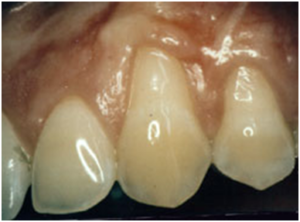What is periodontal gum disease?
Periodontal gum disease is an inflammation of the gum tissue that can progress and eventually affect the gum tissue and bone that support the teeth. There are mainly two different types of gum disease: gingivitis and periodontitis. Untreated gingivitis can advance to periodontitis and can eventually lead to tooth loss and other health problems. If your dentist tells you that you have periodontal gum disease do not fret, you are most certainly not alone. In fact, it has been estimated that a whopping 80 percent of American adults have some form of periodontal gum disease!
Periodontal gum disease is the result of plaque, tartar or calculus buildup on the teeth and gum line. With time, plaque can spread and grow below the gum line. Toxins produced by the bacteria in plaque irritate the gums. The toxins stimulate a chronic inflammatory response in which the body in essence turns on itself, and the tissues and bone that support the teeth are broken down and destroyed. Gums separate from the teeth, forming pockets (spaces between the teeth and gums) that become infected. As the disease progresses, the pockets deepen and more gum tissue and bone are destroyed. Often, this destructive process has very mild symptoms. Eventually, teeth can become loose and may have to be removed.
Periodontal Services
Gum Graft Surgery
Exposed tooth roots are the result of gum recession. Gum graft surgery will repair the defect and help to prevent additional recession and bone loss. In some cases, it can cover exposed roots to protect them from decay. This may reduce tooth sensitivity and improve esthetics of your smile.


Before Gum Graft Surgery After Gum Graft Surgery
Gum grafts can be used to cover roots or develop gum tissue where absent due to excessive gingival recession. During gum graft surgery, your periodontist takes gum tissue from your palate or another donor source to cover the exposed root. This can be done for one tooth or several teeth to even your gum line and reduce sensitivity.
Crown Lengthening
During the dental crown lengthening procedure, excess gum and bone tissue is reshaped to expose more of the natural tooth. This can be done to one tooth, to even your gum line, or to several teeth to expose a natural, broad smile. Your dentist or periodontist may also recommend dental crown lengthening to make a restorative or cosmetic dental procedure possible. Perhaps your tooth is decayed, broken below the gum line, or has insufficient tooth structure for a restoration, such as a crown or bridge. Crown lengthening adjusts the gum and bone level to expose more of the tooth so it can be restored.
Periodontal Pocket Reduction / Regenerative Procedures
A periodontal pocket reduction procedure has been recommended because you have pockets that are too deep to clean with daily at-home oral hygiene and a professional care routine. Reducing pocket depth and eliminating existing bacteria are important to prevent damage caused by the progression of periodontal disease and to help you maintain a healthy smile. Eliminating bacteria alone may not be sufficient to prevent disease recurrence. Deeper pockets are more difficult for you and your dental care professional to clean, so it’s important for you to reduce them. On numerous occasions, regenerative procedures are recommended to regenerate lost bone and tissue supporting your teeth, and they can reverse some of the damage caused by periodontal disease.
During this procedure, your periodontist folds back the gum tissue and removes the disease-causing bacteria. Membranes (filters), bone grafts or tissue-stimulating proteins can be used to encourage your body’s natural ability to regenerate bone and tissue. In some cases, irregular surfaces of the damaged bone are smoothed to limit areas where disease-causing bacteria can hide. This allows the gum tissue to better reattach to healthy bone.
Risk Factors of Periodontal Gum Disease
The main cause of periodontal (gum) disease is plaque, but other factors affect the health of your gums. Here are some things that can increase your likelihood of developing periodontal gum disease.
Smoking and Tobacco Use
Smoking is said to be one of the most significant contributing factors in the development and progression of periodontal disease. Smoking can also prevent some periodontal treatment from working
Diabetes
Those individuals who suffer with diabetes are at an increased risk for developing infections, this includes periodontal gum disease.
Medications
Some medications like antidepressants, some heart drugs, and oral contraceptives can affect your oral health.
Stress
It has been proven that stress impairs our body’s ability to ward off infections, this includes periodontal disease.
Genetics
Unfortunately, some people are inherently more prone to developing periodontal disease than others.
Age
Studies indicate that older people have the highest rates of periodontal disease. Data from the Centers for Disease Control and Prevention indicates that over 70% of Americans 65 and older have periodontitis.
Clenching or Grinding your teeth
Clenching or grinding your teeth can put excess force on the supporting tissues of the teeth and could speed up the rate at which these periodontal tissues are destroyed.

